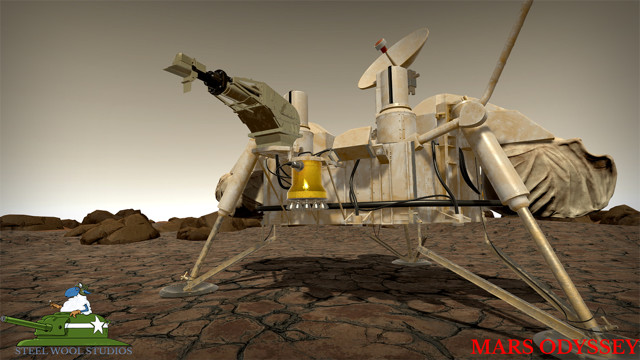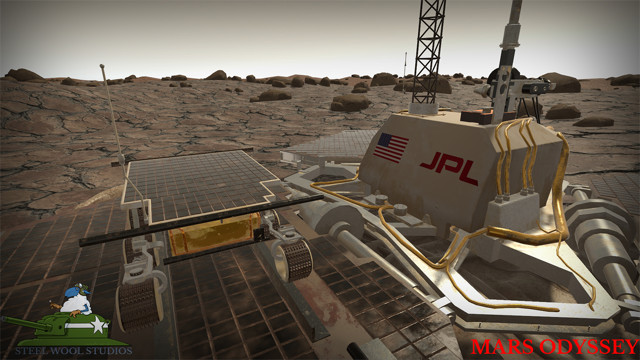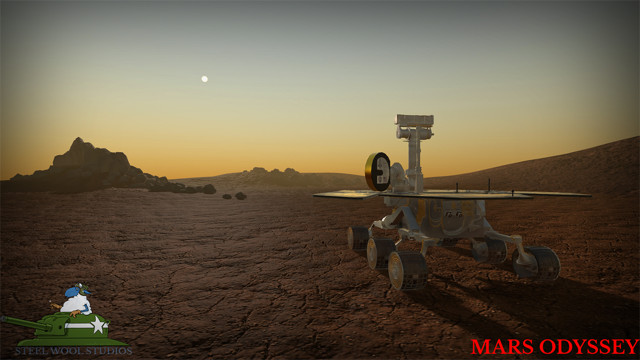If 'Mars Odyssey' Is Any Indication, The Future Of Education With VR Is Incredibly Compelling
Mars Odyssey taught me more about the red planet in less than an hour than I learned about it during four years of high school and more than a decade of personal curiosity since. Steel Wool Studios’ Mars experience should be mandatory curriculum.
The company's Mars Odyssey is a part game, part educational experience. It starts off like any other game, with a quick tutorial that runs you through the basic mechanics that you’ll rely on throughout the experience. The controls are simple: Pull the trigger to grab or use, and press up on the touchpad to teleport.
Once you have the mechanics down pat, you’ll carry on to a holodeck room and start a simulation that will teach you all about the red planet. The presentation blew my mind. I thought I knew a thing or two about Mars, but I had no idea. Did you know that Mars is home to Olympus Mons, the largest volcano in the solar system? Its peak is nearly three times as tall as Mount Everest, and its diameter makes dwarfs that of Earth's tallest mountain. Mars is also home to Valles Marineris, the largest canyon system in the solar system. On Earth, the Grand Canyon is something to behold, but it compared to Valles Marineris, it might as well be a pothole.
It’s hard to visualize the sheer magnitude of these two features of Mars because they are far bigger than anything we can directly compare them too. You could have described Olympus Mons to me with the greatest of detail, and I still wouldn’t have understood the magnitude. Mars Odyssey gives you a visual comparison between landmarks on Mars and landmarks on Earth.
I was already in complete awe of the massive scale of the volcano and canyon on Mars, but my mission hadn’t even begun yet.
Viking 2 Lander
Your first assignment involves repairing the Viking 2 Lander, which touched down on the surface of Mars on September 3, 1976, in the Utopia Planitia region. The years have not been kind to NASA’s second Mars Lander. You’ll have to pick up several components that have fallen off of Viking 2, and you must reattach them using a portable welder.
Once you’ve completed the task, Mars Odyssey gently transitions into a history lesson. Steel Wool Studios provides you with detailed information about the major components that NASA installed on the Viking 2 lander. Once you’ve learned all there is to know about Viking 2 and the region it landed in, return to your pod to move on to the next assignment.
Get Tom's Hardware's best news and in-depth reviews, straight to your inbox.
Pathfinder
The second assignment brought back memories for me. I wasn’t alive yet when Viking 1 and Viking 2 stopped sending transmissions back to Earth. I do remember when NASA sent Pathfinder to Mars, though. This tiny little rover was a big deal when I was in high school, and being in its (virtual) presence was awe inspiring. The Viking 2 Lander is interesting, but it didn’t have the same visceral impact on me as Pathfinder did.
When you see pictures of Pathfinder on the surface of Mars, it's impossible to get a sense of the scale of the device. When you get to walk right up to it, you get a much deeper understanding of just how small and fragile NASA’s $175 million rover is. In fact, the fragility of Pathfinder is the reason you’re at the landing site.
Off in the distance, there’s a sandstorm closing in on the rover’s exploration site. You have to move it to a safer location behind a pile of large rocks, using the touchpad of your left controller as the remote. Essentially, you have to drive the most expensive radio-controlled vehicle ever built. Once the storm passes, you have to drive the rover back to its base station to complete the mission.
Opportunity
Next, you have to save Opportunity from a premature death caused by accumulating dust. Opportunity is a much larger machine compared to the Pathfinder rover. It landed on Mars in 2004 and had been sending data back to earth ever since, but Opportunity’s solar panels have accumulated so much dust over the years that it is not producing power anymore. NASA wants you to clean the panels off so that the medium-sized rover can resume its work.
Once the panels are producing power again, you’ll be able to poke around the rover and learn about the fancy doodads that NASA’s scientists and engineers crammed into the golf-cart sized machine.
Curiosity
NASA’s most recent Mars rover, Curiosity, landed on the red planet four years ago. The Curiosity Rover towers over the rest of the craft that you’ll encounter on the tour. This six-wheeled machine is as big as a compact car.
The Curiosity Rover hasn’t been on Mars long enough to have fallen apart, and it doesn’t have a large array of solar panels that dust can cover, like Opportunity. I don’t want to give away Steel Wool Studios’ interpretation of what NASA’s repair process for its $400 million exploration robot would be, but let's just say it’s a lot less surgical than you might imagine.
Once you’ve completed the repair, you’ll gain access to the details about Curiosity’s history and the sophisticated equipment installed on it.
Education Should Be Engaging Like This
Throughout my experience in Mars Odyssey, one idea kept creeping into my head: This should be the way we teach kids about history. Students would likely be far more engaged in the material than they are by reading a textbook, and in turn, they’ll be more likely to retain the information.
Steel Wool Studios’ Mars Odyssey is a relatively short experience, but the developer isn’t asking much for the game. It's available now on Steam for $4.79 thanks to a 40% introductory discount. The price will go up to $7.99 on September 15.
Kevin Carbotte is a contributing writer for Tom's Hardware who primarily covers VR and AR hardware. He has been writing for us for more than four years.
-
samopa "This should be the way we teach kids about history. Students would likely be far more engaged in the material than they are by reading a textbook, and in turn, they’ll be more likely to retain the information. "Reply
Totally agree with you. When the government read this and start using it ? At least in the Primary School. -
grimfox In certain regards I agree. However, I have to play devil's advocate again. You're looking at a very expensive VR lab, 40 seats @ 2k/seat = 80k USD. Sure learning from a book or seeing more or less the same thing on a tablet/laptop isn't as exciting but for 80k you could probably hire 2 additional teachers. Unless that VR lab is active everyday for the entire school year I feel like the teachers would be a better investment.Reply -
kcarbotte Reply18584923 said:In certain regards I agree. However, I have to play devil's advocate again. You're looking at a very expensive VR lab, 40 seats @ 2k/seat = 80k USD. Sure learning from a book or seeing more or less the same thing on a tablet/laptop isn't as exciting but for 80k you could probably hire 2 additional teachers. Unless that VR lab is active everyday for the entire school year I feel like the teachers would be a better investment.
This is an example of what the FUTURE of education can (will) be.
Vive's won't be this expensive forever (its more like $1500/seat, btw). Prices will come down, accessibility will go up.
More teachers doesn't help make the content engaging for students. I would argue that a technology that encourages students to actually pay attention and take in the subject matter in a meaningful way is a better investment than hiring another teacher or two.




